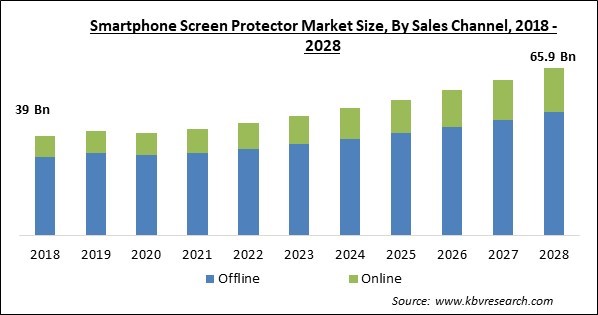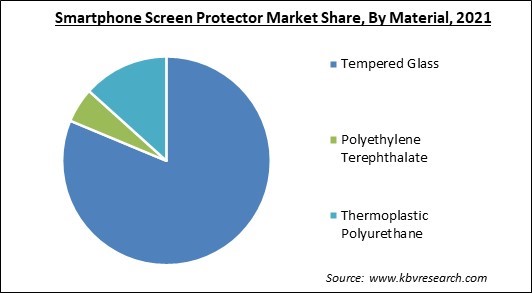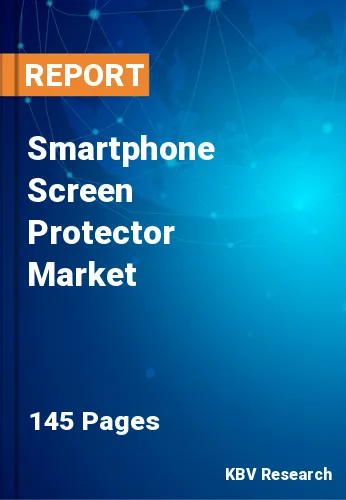The Global Smartphone Screen Protector Market size is expected to reach $65.9 billion by 2028, rising at a Market growth of 6.9% CAGR during the forecast period.
A screen protector is a thin layer of material that is applied to the screen of an electronic gadget to preserve the latter's display from physical damage, most particularly scratches. A screen protector, also known as a screen guard, is typically composed of laminated tempered glass (which looks very similar to the screen of the host device) or plastics including polyethylene terephthalate (PET) or thermoplastic polyurethane (TPU). A plastic screen protector is less expensive, thinner, and more flexible than glass. A glass protector, on the other hand, feels more like the host device's original screen and resists scratches better.
The sight of a broken phone's screen is always unpleasant. Screen protectors, which are thin plastic or glass coverings that may be applied to a smartphone display, claim that their goods will protect the screen against scratches and cracks if it is dropped facing down. Additionally, the majority of cracked smartphone screens are caused by impact on the sides and edges. When a smartphone's corners or edges clash with the ground, the impact is concentrated in a small area and is more likely to shatter, whereas if it fell facing down on the floor, the impact would be spread out over the entire screen.
Screen protectors, help to protect displays from scratches, which can compromise the internal structure of a display and lead to major cracks. Many smartphone manufacturers and sellers provide an extended warranty that allows to exchange or fix the phone if it becomes damaged. The disadvantage is that the price of warranty programs frequently exceeds the cost of individual gadget repairs.
Users are becoming more concerned about mobile devices as a result of technological advancements in smartphone IPS-LCD displays, LED displays, Super AMOLED displays, and boundless displays, among others, because smartphone displays make for a significant amount of the overall cost. As a result, the high cost of luxury smartphones, integrated with the danger of screen breakage, has boosted smartphone screen protector sales in recent years.

The COVID-19 pandemic caused a significant impact on economies worldwide. Companies have adjusted their budget proposals and preferences in response to the COVID-19 pandemic to survive the pandemic. In addition, firms all around the world are significantly financing their operations to keep them going. Local governments are giving improved financial packages to assist businesses in the face of this massive pandemic, with a particular focus on businesses. The COVID-19 pandemic has also spurred the adoption across industrial verticals, as users seek to leverage on benefits including expansion and cost savings. Despite the recent financial slump, about half of subscription businesses are growing at the same rate as before, with no negative impact from the COVID-19 pandemic.
Government subsidies for smartphone manufacturing are rapidly increasing. The cost of cell phones rises as a result of smartphone imports, posing a barrier to their widespread use. Many governments, are stimulating opportunities to motivate domestic smartphone manufacturing. Many valuable mobile phones with a variety of features have recently entered the Market . People are drawn to and purchase these appealing mobile phones, but ensuring their security is also a major responsibility. When the displays on these phones break for any reason, they cannot be recreated in such a manner that they appear to be brand new.
Due to the growing digitalization across the world, the utilization of smartphones is on the rise. With the growing population and the availability and affordability of smartphones on the Market , smartphone adoption has surged. People buy covers, screen protectors, and other accessories for their new smartphones to safeguard the device and display from serious physical damage. The smartphone screen protector Market is predicted to grow as smartphone users become more concerned about protecting their devices' displays from the stresses of day-to-day life. Screen protectors, as the name implies, shield smartphones' screens from scratches and other physical harm.
The halo effect refers to the screen protector's edges that are not linked to the phone. When users place the glass or plastic screen protector over the phone, a halo effect is created. It decreases the screen's visibility and sensitivity. Furthermore, adhesives applied to a screen protector that is under stress make it simpler for it to shatter and lose its effectiveness. Additionally, the pressured glued piece could crack the screen guard and possibly harm the person if not careful. Due to the usage of adhesives, changing the tempered glass screen guard is a complex process. Plastic screen protectors also deteriorate their clarity over time, resulting in cloudiness and an unpleasant appearance.

Based on Sales Channel, the Market is segmented into Offline and Online. The offline segment acquired the highest revenue share in the smartphone screen protector Market in 2021. The majority of consumers still choose to buy things in offline shops rather than online portals because physical validation of the products available in-store. It also eliminates the necessity to spend shipping fees and offers the possibility of interacting with a sales representative for more details of the product.
Based on Material, the Market is segmented into Tempered Glass, Polyethylene Terephthalate, and Thermoplastic Polyurethane. The thermoplastic polyurethane segment recorded a significant revenue share in the smartphone screen protector Market in 2021. It is resistant to damage, oil accumulation, and grease, which is one of the advantages of utilizing this sort of screen protector. This flexibility also allows the screen guard to self-heal, which is important when utilizing these screen protectors. These screen protectors are appropriate with bigger displays and in-screen fingerprints, both of which are growing increasingly common among new smartphones due to the material's physiochemical qualities. They frequently also offer full-screen protection.
| Report Attribute | Details |
|---|---|
| Market size value in 2021 | USD 41.8 Billion |
| Market size forecast in 2028 | USD 65.9 Billion |
| Base Year | 2021 |
| Historical Period | 2018 to 2020 |
| Forecast Period | 2022 to 2028 |
| Revenue Growth Rate | CAGR of 6.9% from 2022 to 2028 |
| Number of Pages | 145 |
| Number of Tables | 248 |
| Report coverage | Market Trends, Revenue Estimation and Forecast, Segmentation Analysis, Regional and Country Breakdown, Companies Strategic Developments, Company Profiling |
| Segments covered | Sales Channel, Material, Region |
| Country scope | US, Canada, Mexico, Germany, UK, France, Russia, Spain, Italy, China, Japan, India, South Korea, Singapore, Malaysia, Brazil, Argentina, UAE, Saudi Arabia, South Africa, Nigeria |
| Growth Drivers |
|
| Restraints |
|
Based on Regions, the Market is segmented into North America, Europe, Asia Pacific, and Latin America, Middle East & Africa. The North America registered a substantial revenue share in the smartphone screen protector Market in 2021. North America is predicted to grow during the forecast period, owing to the growing adoption of high-priced smartphones with superior technologies. High-quality items outnumber pricey cellphones in the Market . By its superior damage resistance properties, upsurge for tempered glass products is expected to drive product Market during the forecast period. Furthermore, increased consumer disposable income, coupled with higher consumption of secure smartphone peripherals, is expected to result in increased growth during the forecast period.
Free Valuable Insights: GlobalSmartphone Screen Protector Market size to reach USD 65.9 Billion by 2028
The Market research report covers the analysis of key stake holders of the Market . Key companies profiled in the report include ZAGG, Inc., NuShield, Inc., XtremeGuard, Clarivue, 3M Company, Corning Incorporated, Belkin International, Inc., and Nippon Electric Glass Co., Ltd.
By Sales Channel
By Material
By Geography
The global smartphone screen protector market size is expected to reach $65.9 billion by 2028.
Increasing government subsidies for smartphone production are increasing are driving the market in coming years, however, the existence of a halo effect in glass screen protectors growth of the market.
ZAGG, Inc., NuShield, Inc., XtremeGuard, Clarivue, 3M Company, Corning Incorporated, Belkin International, Inc., and Nippon Electric Glass Co., Ltd.
The Tempered Glass segment is leading the Global Smartphone Screen Protector Market by Material in 2021, thereby, achieving a Market value of $51.6 billion by 2028.
The Asia Pacific is the fastest growing region in the Global Smartphone Screen Protector Market by Region in 2021.
Our team of dedicated experts can provide you with attractive expansion opportunities for your business.

